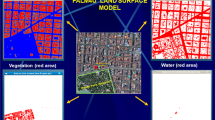Abstract
Air pollution exposure is a major environmental risk to health and has been estimated to be responsible for 7 million premature deaths worldwide every year. This is of special concern in cities, where there are high levels of pollution and high population densities. Not only is there an urgent need for cities to monitor, analyze, predict and inform residents about the air quality, but also to develop tools to help evaluate mitigation strategies to prevent contamination. In this respect, the Weather Research and Forecasting model coupled with chemistry (WRF-Chem) is useful in providing simulations of meteorological conditions but also of the concentrations of polluting species. When combined with the multi-layer urban scheme Building Effect Parameterization (BEP) coupled with the Building Energy Model (BEM), we are furthermore able to include urban morphology and urban canopy effects into the atmosphere that affect the chemistry and transport of the gases. However, using WRF-Chem+BEP/BEM is computationally very expensive especially at very high urban resolutions below 5 km. It is thus indispensable to properly analyze the performance of these models in terms of execution time and quality to be useful for both operational and reanalysis purposes. This work represents the first step towards this overall objective which is to determine the performance (in terms of computational time and quality of results) and the scalability of WRF-BEP/BEM. To do so, we use the case study of Metropolitan Area of Barcelona and analyze a 24-h period (March 2015) under two with different Urban schemes (Bulk and BEP/BEM). We analyze the execution time by running the two experiments in its serial configuration and in their parallel configurations using 2, 4, 8, 16, 32 and 64 cores. And the quality of the results by comparing to observed data from four meteorological stations in Barcelona.
Access this chapter
Tax calculation will be finalised at checkout
Purchases are for personal use only
Similar content being viewed by others
References
Chen, F., et al.: The integrated WRF/urban modelling system: development, evaluation, and applications to urban environmental problems. Int. J. Climatol. 31(2), 273–288 (2011). https://doi.org/10.1002/joc.2158
Farguell, A., Cortés, A., Margalef, T., Miró, J.R., Mercader, J.: Scalability of a multi-physics system for forest fire spread prediction in multi-core platforms. J. Supercomput. 75(3), 1163–1174 (2019). https://doi.org/10.1007/s11227-018-2330-9
GOOGLE: Coronavirus (COVID-19). https://news.google.com/covid19/map
Grell, G.A., et al.: Fully coupled “online” chemistry within the WRF model. Atmos. Environ. 39(37), 6957–6975 (2005). https://doi.org/10.1016/j.atmosenv.2005.04.027
Hersbach, H., et al.: The ERA5 global reanalysis. Q. J. Roy. Meteorol. Soc. 146(730), 1999–2049 (2020). https://doi.org/10.1002/qj.3803
Kuehn, B.: Who: more than 7 million air pollution deaths each year. JAMA, J. Am. Med. Assoc. 311, 1486 (2014). https://doi.org/10.1001/jama.2014.4031
Kusaka, H., Kimura, F.: A simple single-layer urban canopy model for atmospheric models: comparison with multi-layer and SLAB models. Bound.-Layer Meteorol. 101(ii), 329–358 (2001). https://doi.org/10.1023/A:1019207923078
Martilli, A., Clappier, A., Rotach, M.W.: An urban surface exchange parameterisation for mesoscale models. Bound.-Layer Meteorol. 104(2), 261–304 (2002). https://doi.org/10.1023/A:1016099921195
de la Paz, D., Borge, R., Martilli, A.: Assessment of a high resolution annual WRF-BEP/CMAQ simulation for the urban area of Madrid (Spain). Atmos. Environ. 144, 282–296 (2016). https://doi.org/10.1016/j.atmosenv.2016.08.082
Ribeiro, I., Martilli, A., Falls, M., Zonato, A., Villalba, G.: Highly resolved WRF-BEP/BEM simulations over Barcelona urban area with LCZ. Atmos. Res. 248, 105220 (2021). https://doi.org/10.1016/j.atmosres.2020.105220
Salamanca, F., Krpo, A., Martilli, A., Clappier, A.: A new building energy model coupled with an urban canopy parameterization for urban climate simulations-part I. Formulation, verification, and sensitivity analysis of the model. Theor. Appl. Climatol. 99(3–4), 331–344 (2010). https://doi.org/10.1007/s00704-009-0142-9
Salamanca, F., Martilli, A.: A new building energy model coupled with an urban canopy parameterization for urban climate simulations-part II. Validation with one dimension off-line simulations. Theor. Appl. Climatol. 99(3–4), 345–356 (2010). https://doi.org/10.1007/s00704-009-0143-8
Shainer, G., et al.: Weather research and forecast (WRF) model: performance analysis on advanced multi-core HPC clusters. In: The 10th LCI International Conference on High Performance Clustered Computing, pp. 1–14 (2009)
Skamarock, W., Al., E.: A description of the advanced research WRF model version 4. NCAR (2019)
SMC: Climatic report. Servei Meteorològic de Catalunya. Departament de Territori i Sostenibilitat, March 2015. https://www.meteo.cat/wpweb/climatologia/el-clima-ara/butlleti-mensual/
Tetzner, D., Thomas, E., Allen, C.: A validation of ERA5 reanalysis data in the southern Antarctic peninsula-Ellsworth land region, and its implications for ice core studies. Geosciences 9(7), 289 (2019). https://doi.org/10.3390/geosciences9070289
WHO: Air pollution deaths per year. https://www.who.int/news-room/air-pollution
Wilmoth, J.: Global demographic projections: future trajectories and associated uncertainty. https://www.un.org/en/development/desa/population/commission/pdf/48/sideEvents/14April2015_GlobalPopulationProjections_Presentation.pdf
Acknowledgments
This research has been supported by MINECO-Spain under contract TIN2017-84553-C2-1-R, and by the Spanish government under grant PRE2018-085425.
Author information
Authors and Affiliations
Corresponding author
Editor information
Editors and Affiliations
Rights and permissions
Copyright information
© 2021 Springer Nature Switzerland AG
About this paper
Cite this paper
Vidal, V., Cortés, A., Badia, A., Villalba, G. (2021). Evaluating WRF-BEP/BEM Performance: On the Way to Analyze Urban Air Quality at High Resolution Using WRF-Chem+BEP/BEM. In: Paszynski, M., Kranzlmüller, D., Krzhizhanovskaya, V.V., Dongarra, J.J., Sloot, P.M. (eds) Computational Science – ICCS 2021. ICCS 2021. Lecture Notes in Computer Science(), vol 12746. Springer, Cham. https://doi.org/10.1007/978-3-030-77977-1_41
Download citation
DOI: https://doi.org/10.1007/978-3-030-77977-1_41
Published:
Publisher Name: Springer, Cham
Print ISBN: 978-3-030-77976-4
Online ISBN: 978-3-030-77977-1
eBook Packages: Computer ScienceComputer Science (R0)




